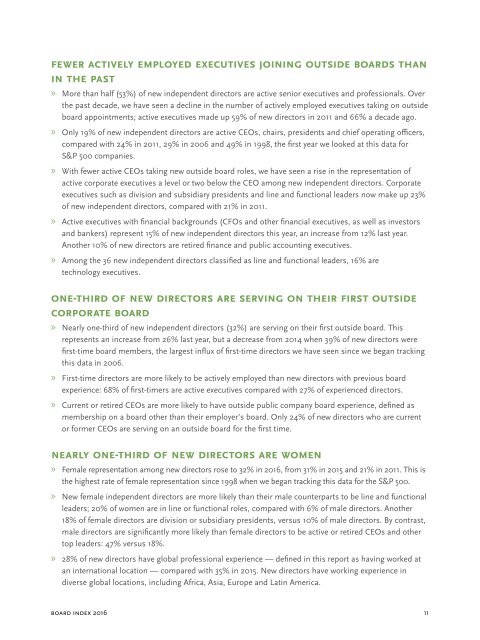Spencer Stuart Board Index
2ipnQXb
2ipnQXb
Create successful ePaper yourself
Turn your PDF publications into a flip-book with our unique Google optimized e-Paper software.
Fewer actively employed executives joining outside boards than<br />
in the past<br />
»»<br />
More than half (53%) of new independent directors are active senior executives and professionals. Over<br />
the past decade, we have seen a decline in the number of actively employed executives taking on outside<br />
board appointments; active executives made up 59% of new directors in 2011 and 66% a decade ago.<br />
»»<br />
Only 19% of new independent directors are active CEOs, chairs, presidents and chief operating officers,<br />
compared with 24% in 2011, 29% in 2006 and 49% in 1998, the first year we looked at this data for<br />
S&P 500 companies.<br />
»»<br />
With fewer active CEOs taking new outside board roles, we have seen a rise in the representation of<br />
active corporate executives a level or two below the CEO among new independent directors. Corporate<br />
executives such as division and subsidiary presidents and line and functional leaders now make up 23%<br />
of new independent directors, compared with 21% in 2011.<br />
»»<br />
Active executives with financial backgrounds (CFOs and other financial executives, as well as investors<br />
and bankers) represent 15% of new independent directors this year, an increase from 12% last year.<br />
Another 10% of new directors are retired finance and public accounting executives.<br />
»»<br />
Among the 36 new independent directors classified as line and functional leaders, 16% are<br />
technology executives.<br />
One-third of new directors are serving on their first outside<br />
corporate board<br />
»»<br />
Nearly one-third of new independent directors (32%) are serving on their first outside board. This<br />
represents an increase from 26% last year, but a decrease from 2014 when 39% of new directors were<br />
first-time board members, the largest influx of first-time directors we have seen since we began tracking<br />
this data in 2006.<br />
»»<br />
First-time directors are more likely to be actively employed than new directors with previous board<br />
experience: 68% of first-timers are active executives compared with 27% of experienced directors.<br />
»»<br />
Current or retired CEOs are more likely to have outside public company board experience, defined as<br />
membership on a board other than their employer’s board. Only 24% of new directors who are current<br />
or former CEOs are serving on an outside board for the first time.<br />
Nearly one-third of new directors are women<br />
»<br />
» Female representation among new directors rose to 32% in 2016, from 31% in 2015 and 21% in 2011. This is<br />
the highest rate of female representation since 1998 when we began tracking this data for the S&P 500.<br />
»»<br />
New female independent directors are more likely than their male counterparts to be line and functional<br />
leaders; 20% of women are in line or functional roles, compared with 6% of male directors. Another<br />
18% of female directors are division or subsidiary presidents, versus 10% of male directors. By contrast,<br />
male directors are significantly more likely than female directors to be active or retired CEOs and other<br />
top leaders: 47% versus 18%.<br />
»»<br />
28% of new directors have global professional experience — defined in this report as having worked at<br />
an international location — compared with 35% in 2015. New directors have working experience in<br />
diverse global locations, including Africa, Asia, Europe and Latin America.<br />
board index 2016 11


